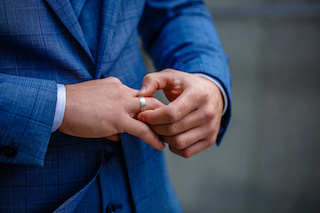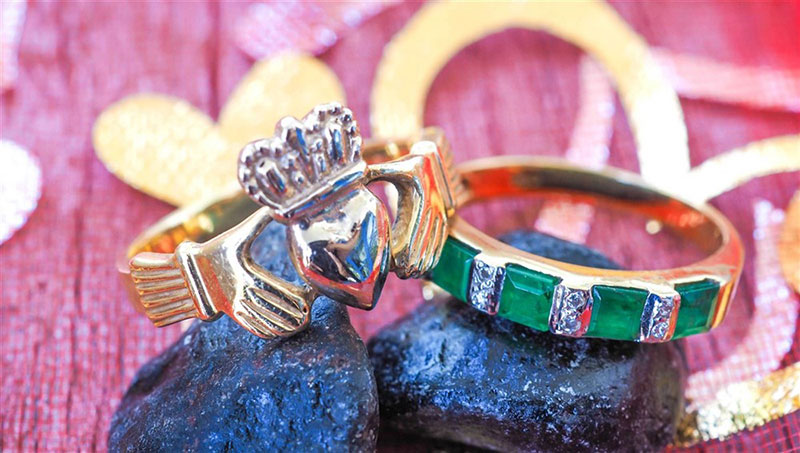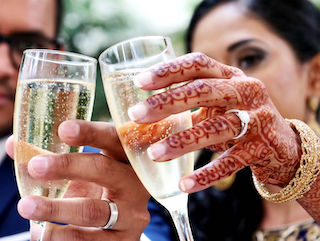More than anything, engagement rings serve as symbols. They are worn, not just for your own benefit, but to signal to others that you are in a committed relationship. For the symbology of engagement rings to effectively relay their message, specific etiquette protocols regarding their wear have evolved. In our current, integrated, global society, some of these protocols, such as which finger rings are worn, are standard, while some traditions maintain regional significance.
History of the Engagement Ring
The tradition of wearing an engagement ring (metal or organic) stretches back thousands of years, tracing its roots to Ancient Roman culture. Then, rings symbolized love or a formal commitment. The modern tradition of engagement rings were ratified in the ninth century when Pope Nicholas I declared that the giving of a ring by a man to a woman signified his commitment to a future union.

Most men and women living in the US, Canada, and parts of Europe wear both their engagement and wedding rings on the fourth finger of their left hand. This tradition originated from the Ancient Roman belief in the existence of the Vena Amoris, or “vein of love”, that led directly from that finger to the heart. Thus, wearing a ring there forged an intimate and physical connection between the band and the wearer’s actual heart. Althought we now know that the Vena Amoris doesn’t exist, the ritual stuck. As such, engagement rings are usually worn in this way until the wedding day. At that point, the ring is transferred to the fourth finger of the right hand so that the wedding band may be placed on the left finger. Finally, once the wedding band is on, the engagement ring is moved back to the left hand. This is so it may serve as a protective guard for the wedding band which is worn closer to the heart.
Latin America Traditions
Latin American traditions include engagement rings for men more commonly than we are accustomed to in the US. It is conventional for couples to wear engagement rings on the fourth fingers of their right hands until their wedding day when the rings are transferred to the left hands.

European Traditions
While much of Europe maintains similar traditions to the US, etiquette is mixed and some individual countries have different practices. For instance, women from Russia and Norway, amongst others, wear engagement rings on their right hands. This ritual stems from antiquated beliefs that the left hand is inferior to the right.
If you have an Irish heritage, you are probably familiar with the Claddagh ring. This distinctive ring features a crowned heart held with two hands symbolizing friendship, love, and loyalty. It may or may not feature gemstones. There are many different messages that can be relayed depending on how the Claddagh ring is worn. It can be a symbol of friendship, or an indication of the wearer’s single-status. More frequently, it is employed as an engagement ring. This is shown by wearing it on the left-hand facing inward. The Claddagh ring transforms into a wedding ring by flipping it so that it faces outward.

Asian Traditions
Asian cultures have a variety of differing traditions related to the wearing of engagement rings. Japanese women may receive engagement rings, but don’t usually wear them after they marry. Some brides-to-be in India may wear engagement rings on their right hands, again, referencing the belief in the superiority of the right hand. However, many local groups use alternative types of jewelry such as bangles or toe-rings to show a person’s engagement status. Similarly, several African cultures employ other kinds of jewelry to signal an engagement.

Traditions are all Intertwined
Perhaps because our world is so interconnected, rules really are no longer set in stone. There are some beautiful traditions surrounding engagement rings from all over the world. You can choose which conventions to follow based on your heritage, where you currently live, or what practices you personally prefer. Particularly in the US – a country made up of immigrants – many choose to honor the conventions of their ancestral cultures.
Although the goal of an engagement is that it lasts forever, a final element of etiquette to learn from a legal standpoint is which party keeps the ring in case of a breakup. Most states in the US consider engagement rings to be “conditional gifts”. This means that the gift is given with the understanding that a marriage is to follow. Should that marriage not happen, the ring goes back to whomever purchased it. Other states decide who gets the ring based on which party broke off the engagement. In these communities, the person who breaks off the engagement must surrender the ring to the other party.
Once the marriage has been performed, there are two legal positions that states take. The first and most common position is that the recipient of the engagement ring may keep it since the condition of marriage was fulfilled. Conversely, some states consider the ring to be community property and the value of the ring is split in the event of a divorce.

